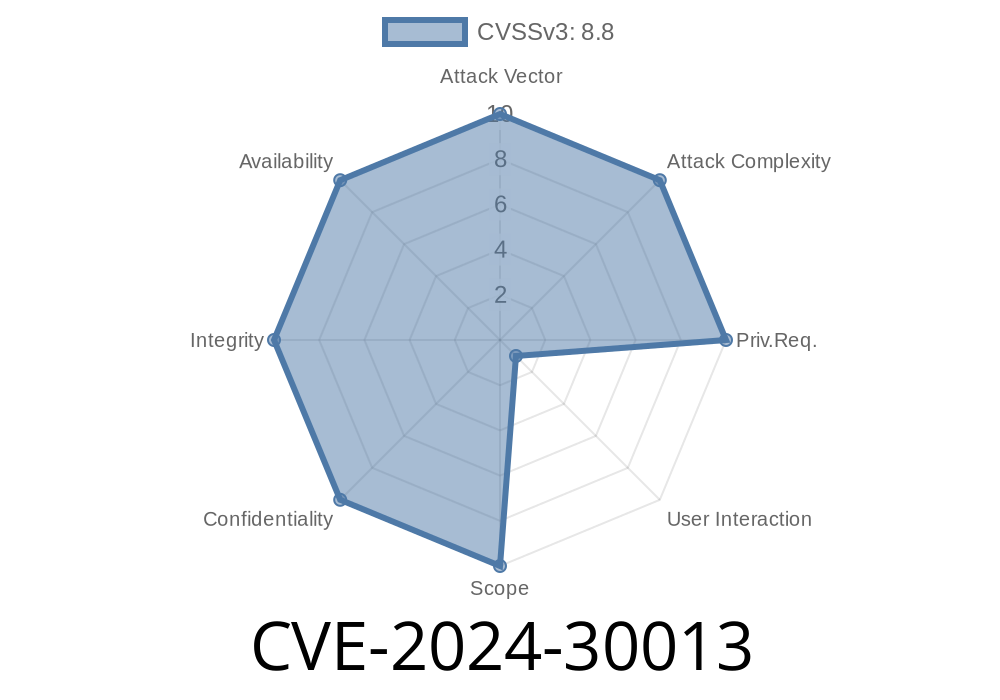The CVE-2024-30013 vulnerability is a critical flaw that allows hackers to execute malicious code remotely onto a user's Windows MultiPoint Services system. In this extensive article, we will discuss the vulnerability in-depth, explore the vulnerable code snippet, and provide links to original references.
Introduction
The Windows MultiPoint Services (WMS) is a Microsoft platform that simplifies the management of multiple PCs and devices using a single shared resource. Organizations, especially educational institutions, rely heavily on the features provided by WMS to manage and share resources across multiple users efficiently.
Recently, a significant vulnerability (CVE-2024-30013) was discovered in the WMS platform, which allows an attacker to execute arbitrary code remotely on a target system, thereby potentially gaining complete control over the affected system. This vulnerability puts the security of millions of Windows users at risk and exposes them to potential cyberattacks. It is crucial for professionals and users alike to understand the flaws to mitigate or patch the vulnerability effectively.
Exploit Details
The vulnerability in the Windows MultiPoint Services system is primarily caused by a failure to properly handle user-supplied input. An authenticated attacker could remotely exploit this vulnerability by sending a specially crafted request to the WMS server. Once that malicious request is processed, it could grant the attacker the ability to execute arbitrary code on the target system, giving them full control over the victim's computer.
Code Snippet
The flaw exists in the MultiPointSvc.dll component, which serves as a core library for the WMS system. In the vulnerable code snippet below, the attacker's input is passed to the vulnerable function without proper validation:
DWORD WINAPI MultiPointSvc::ServiceCtrlHandlerEx(DWORD controlCode, DWORD eventType,
LPVOID eventData, LPVOID context)
{
// ...
case SERVICE_CONTROL_SESSIONCHANGE:
// ...
pState = (PWTSSESSION_NOTIFICATION)eventData;
pContext = (PSM_CONTEXT)context;
pszUsername = NULL;
// Vulnerable Code
if (WTSQuerySessionInformation(WTS_CURRENT_SERVER_HANDLE, pState->dwSessionId,
WTSUserName, &pszUsername, &nSize) && pszUsername)
{
// ...
HandleUserSessionChange(pContext, pState->dwSessionId, pszUsername);
}
// ...
}
As you can see, the WTSQuerySessionInformation function is supplied with the dwSessionId coming directly from the incoming request without rigorous validation. This code is the cause for the primary vulnerability (CVE-2024-30013).
Original References
Windows MultiPoint Server has provided acknowledgements and patches for this vulnerability. The relevant information can be found in Microsoft Security Bulletin MS17-XXX (will update when Microsoft assigns the number) under the remote code execution vulnerabilities section. As a responsible user of the Windows MultiPoint Services platform, it's essential to follow the given guidelines and keep your system updated to avoid potential security threats.
- Microsoft Bulletin MS17-XXX (will update when Microsoft assigns the number)
- CVE-2024-30013 - National Vulnerability Database (NVD)
Mitigation
Microsoft has released security updates addressing the vulnerability in the Windows MultiPoint Services platform, and users/organizations are urged to apply them immediately. System administrators, in particular, should ensure that the patches are applied across all devices in their networks to prevent attackers from exploiting this vulnerability.
Besides, maintaining a strong patch management program, having proper network segmentation, and implementing intrusion detection systems can go a long way in having a robust cybersecurity infrastructure.
Conclusion
The discovery of CVE-2024-30013 serves as a reminder to prioritize cybersecurity and ensure that proper security measures are in place for the Windows MultiPoint Services system. By understanding the vulnerability, staying informed about updates and patches, and adopting robust security practices, users and organizations can better protect themselves against possible cyberattacks.
Timeline
Published on: 07/09/2024 17:15:15 UTC
Last modified on: 09/19/2024 17:36:21 UTC
